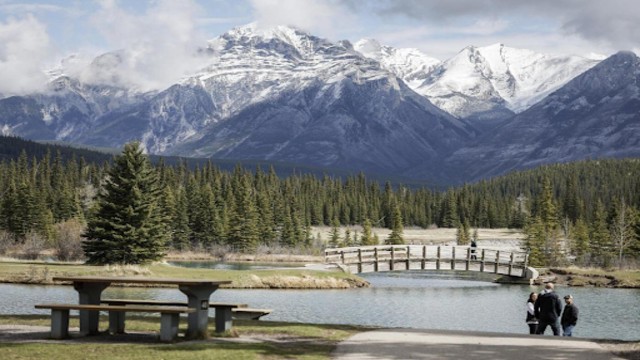
An artist from Dewars Farm has created an illustration showing what the Megalosaurus (left) and Cetiosaurus (right) might have looked like during the Middle Jurassic Period, in present-day Oxfordshire, England. CNN
Scientists have uncovered nearly 200 dinosaur footprints dating back 166 million years to the Middle Jurassic Period at Dewars Farm Quarry in Oxfordshire, England. This extraordinary discovery, first noticed in 2023, has earned the name "dinosaur highway" due to the extensive paths left by the dinosaurs.
The discovery began when quarry worker Gary Johnson noticed unusual bumps on the ground while extracting limestone for road construction. This led to the identification of several dinosaur tracks embedded in the quarry floor. While other Jurassic pathways have been found worldwide, this site in Oxfordshire holds the distinction of being the largest dinosaur track site in the UK.
The excavation, which took place in June 2024, involved around 100 volunteers from the University of Birmingham and the University of Oxford. These experts worked for one week to excavate and document the vast array of tracks, revealing the remarkable scale of this prehistoric site.
The find is especially significant as it marks the 200th anniversary of the discovery of Megalosaurus, the first dinosaur ever formally described in 1824, also found in Oxfordshire. "There’s a really long legacy in this area of exciting dinosaur tracks and body fossils," said Kirsty Edgar, a professor at the University of Birmingham, involved in the excavation.
These new footprints are connected to an older trackway found in the same quarry in 1997, although that site is no longer accessible. However, the new tracks offer scientists a fresh opportunity to gain new insights into the movements, diets, and social behaviors of dinosaurs, something that wasn’t possible with the earlier tracks.
In June 2024, a group of volunteers gathered to carefully study the dinosaur footprints discovered at the Oxfordshire quarry. CNN
The excavation uncovered five major trackways, with the longest measuring over 150 meters (492 feet). Four of the tracks belonged to massive, long-necked sauropods, likely the Cetiosaurus, which could grow up to 18 meters (59 feet) in length. The largest of these tracks were around 90 centimeters (35 inches) long.
Sauropods, according to paleoecologist Lawrence Tanner, were enormous, herbivorous dinosaurs similar in size to modern-day elephants. The tracks primarily showed impressions of their hind feet, which were larger than their front feet. These dinosaurs likely moved at a slow pace of about 5 kilometers per hour (3 miles per hour), comparable to the walking speed of a human.
The fifth trackway contained footprints from the predatory Megalosaurus, a large theropod with distinctive three-toed prints. Researchers found tracks up to 65 centimeters (2.1 feet) long, showing the Megalosaurus was also moving at a slow, leisurely pace. Interestingly, its path intersected with the sauropod tracks, indicating that the predator may have passed through the area shortly after the herbivores.
Although it’s difficult to determine exactly where the dinosaurs were headed, experts speculate that they could have been traveling along the shoreline or moving around trees in search of food.
In June 2024, volunteers spent a week carefully clearing away debris from the dinosaur tracks to uncover and examine the full extent of the footprints. CNN
The unique preservation of these tracks is rare. The area was likely covered in soft sediment and had an ideal water balance, preserving the footprints over millions of years. The tracks were eventually covered by a storm, which protected them from erosion.
Unlike bones, which natural forces can move, dinosaur tracks provide direct insights into the behavior and movements of these creatures. "It’s like a snapshot into the day of the dinosaurs’ life," said Edgar. The tracks can reveal information about group dynamics, predator-prey interactions, and how the dinosaurs responded to changes in their environment.
During the excavation, the team captured over 20,000 images of the site using aerial drones. These images will be used to create detailed 3D models of the tracks, offering scientists further opportunities to study the biomechanics and interactions of these ancient animals.
Although much of the site has already been documented, Edgar noted that significant portions remain unexplored, offering the potential for more discoveries as quarrying continues. "We would hope to be doing excavations each summer," she said.















